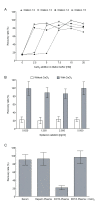Development of an enzyme-linked immunosorbent assay for the detection of human calretinin in plasma and serum of mesothelioma patients
- PMID: 20509881
- PMCID: PMC2886046
- DOI: 10.1186/1471-2407-10-242
Development of an enzyme-linked immunosorbent assay for the detection of human calretinin in plasma and serum of mesothelioma patients
Abstract
Background: Calretinin is one of the well-established immunohistochemical markers in the diagnostics of malignant mesothelioma (MM). Its utility as a diagnostic tool in human blood, however, is scarcely investigated. The aim of this study was to develop an enzyme-linked immunosorbent assay (ELISA) for human calretinin in blood and to assess its usefulness as a potential minimally invasive diagnostic marker for MM.
Methods: Initially, attempts were made to establish an assay using commercially available antibodies and to optimize it by including a biotin-streptavidin complex into the assay protocol. Subsequently, a novel ELISA based on polyclonal antibodies raised in rabbit immunized with human recombinant calretinin was developed. The assay performance in human serum and plasma (EDTA/heparin) and the influence of calcium concentrations on antibody recognition were studied. Stability of spiked-in calretinin in EDTA plasma under different storage conditions was also examined. In preliminary studies serum and plasma samples from 97 healthy volunteers, 35 asbestos-exposed workers, and 42 MM patients were analyzed.
Results: The mean detection range of the new ELISA was 0.12 to 8.97 ng/ml calretinin. The assay demonstrated markedly lower background and significantly higher sensitivity compared to the initially contrived assay that used commercial antibodies. Recovery rate experiments confirmed dependence of calretinin antibody recognition on calcium concentration. Calcium adjustment is necessary for calretinin measurement in EDTA plasma. Spiked-in calretinin revealed high stability in EDTA plasma when stored at room temperature, 4 degrees C, or after repeated freeze/thaw cycles. Median calretinin values in healthy volunteers, asbestos workers, and MM patients were 0.20, 0.33, and 0.84 ng/ml, respectively (p < 0.0001 for healthy vs. MM, p = 0.0036 for healthy vs. asbestos-exposed, p < 0.0001 for asbestos-exposed vs. MM). Median values in patients with epithelioid and biphasic MM were similar. No influence of age, gender, smoking status, or type of medium (plasma/serum) on calretinin values was found.
Conclusions: The novel assay is highly sensitive and applicable to human serum and plasma. Calretinin appears to be a promising marker for the blood-based detection of MM and might complement other markers. However, further studies are required to prove its usefulness in the diagnosis of MM patients.
Figures




References
-
- Greillier L, Baas P, Welch JJ, Hasan B, Passioukov A. Biomarkers for malignant pleural mesothelioma: current status. Mol Diagn Ther. 2008;10(6):375–390. - PubMed
Publication types
MeSH terms
Substances
LinkOut - more resources
Full Text Sources
Medical

